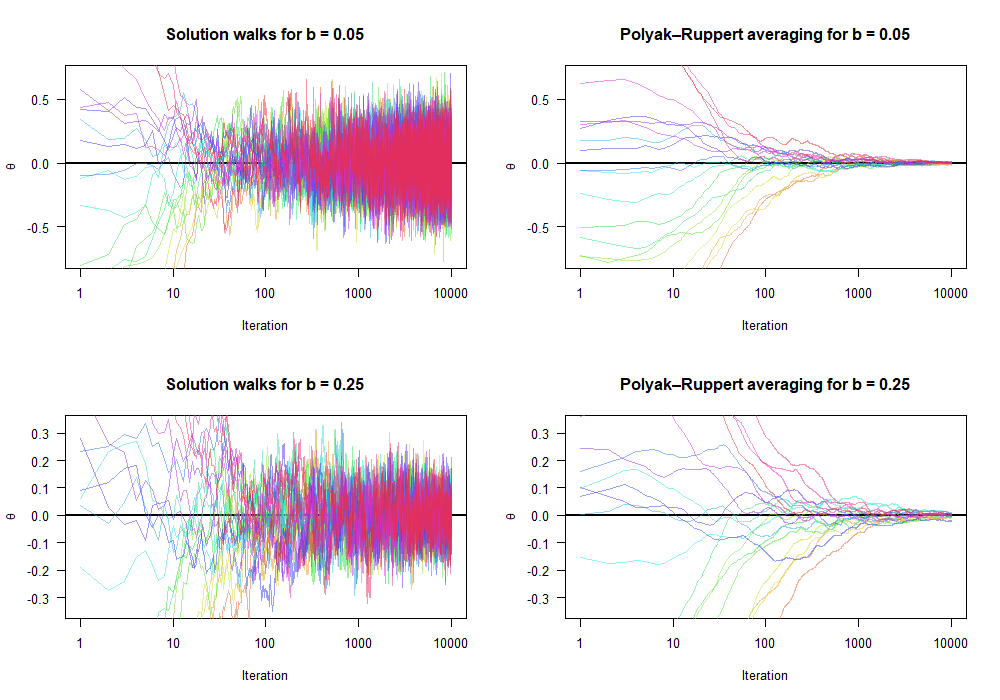It seems to be performing just fine.
Let's do a small study. The plots below document 10,000 steps of the process of finding the root $\theta$ for four values of $b$ (indicated in their titles) and 20 values of the initial estimate $a$ (randomly chosen at the outset and common to all four panels). The colors indicate the values of $a.$ (Because these are a form of random walk, I call them "walks" in the titles.)

I included two values of $b$ outside the stipulated range, $b=1/4$ and $b=2,$ just to see what happens. In the first case the solution converges in expectation but oscillates too much. In the second case the solution converges but does not arrive at the correct value: it is controlled too much by the initial value $a.$
The intermediate cases, for $b=0.6$ and $b=1,$ exhibit acceptable hybrids of these behaviors: they converge to the (correct) solution and they oscillate less and less over time. As $b$ grows, the amount of oscillation reduces, but it takes longer to reach the solution. (Pay attention to the different vertical scales in the plots.)
Several lessons are immediate:
Do not terminate the process based only on the most recent difference. Review the entire trajectory.
Do not find the root just once: do it several times, restarting with different initial values.
Consider starting with small $b$ (near $1/2$) to home in on the answer quickly and then "polishing" that by restarting with the apparent solution and a large value of $b$ (near $1$).
Here is the R code for the study. The implementation of the Robbins-Munro method is facilitated by treating the function as a black box f and exploiting the Reduce function to perform the updating and storing of the trajectory after first computing all the step sizes lambda in advance. Notably, given f, lambda, and a starting value a, this implementation is a one-liner:
Reduce(function(y, lambda) y - lambda * f(y), lambda, a, accumulate=TRUE)
f <- function(x) {
1/(1 + exp(-x/2)) - 1/2 + rnorm(length(x), sd=0.1)
}
#
# Specify the study parameters.
#
set.seed(17)
iterations <- seq_len(1e4) # Specify the number of iterations
burn.period <- 1e2 # Skip these initial results when scaling the plots
replicates <- 20 # Specify how many starting values to use
bs <- c(0.25, 0.6, 1, 2) # Specify which `b` values to explore
as <- sort(rt(replicates, 2)) # Draw the starting values randomly
#
# Perform the study.
#
par(mfrow=c(2,2))
colors <- hsv(seq_along(as)/length(as), .8, .9, .5)
for (b in bs) {
#
# Find the solutions for each starting value `a`.
#
lambda <- iterations^(-b)
solutions <- sapply(as, function(a) {
Reduce(function(y, lambda) y - lambda * f(y), lambda, a, accumulate=TRUE)
})
#
# Prepare to plot all the trajectories.
#
r <- range(solutions[-seq_len(burn.period), ])
plot(range(iterations), r,
log="x", type="n", xlab="Iteration", ylab=expression(theta), las=1,
main=paste("Solution walks for b =", b))
abline(h=0, lwd=2)
#
# Plot the trajectories.
#
sapply(seq_len(ncol(solutions)), function(j) {
theta <- solutions[-1, j]
lines(iterations, theta, cex=3/4, col=colors[j])
})
}
par(mfrow=c(1,1))


